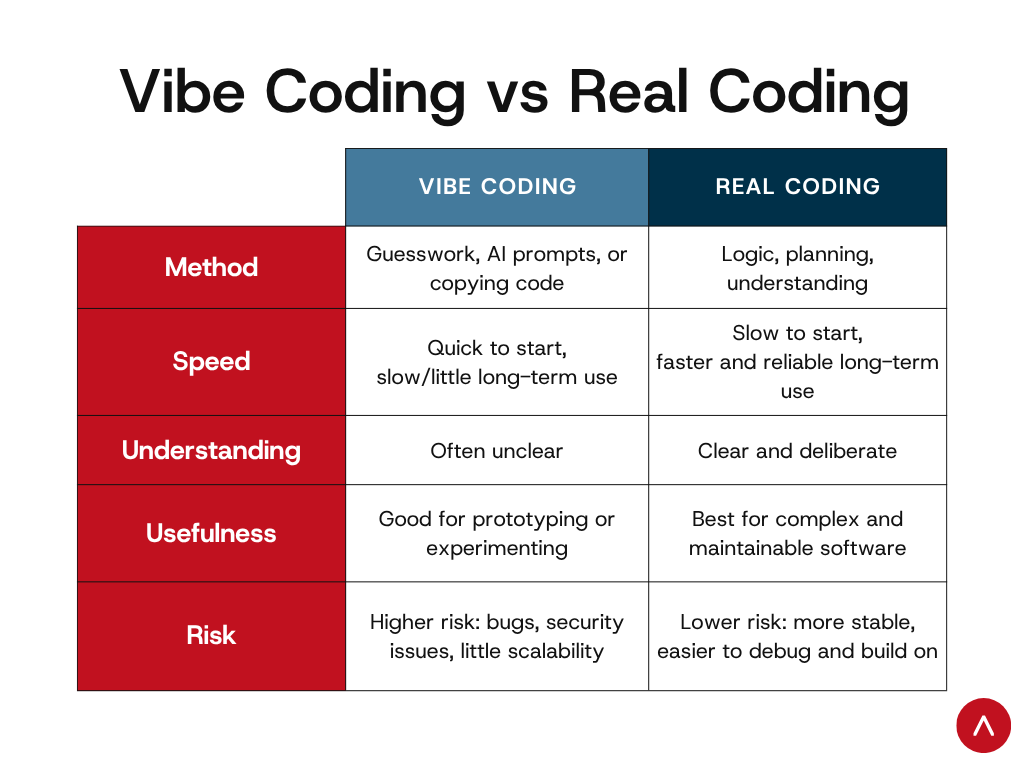If you’re interested in software development, you might have come across a new term: vibe coding. It sounds fun, but what is it exactly? And importantly, can it replace the traditional, hands-on coding currently used by developers?
What is vibe coding?
Vibe coding is writing code based on gut feeling or AI suggestions, without fully understanding why the code works. In practice, that usually means asking ChatGPT or GitHub Copilot to write code for you, or finding pre-written code to copy and paste from the internet, then tweaking the code based on instinct and guesses until it seems to work. In short, as the name suggests, it’s coding based on vibes, not solid knowledge.
Vibe coding compared to traditional coding methods:
Here’s a quick breakdown of the difference between vibe coding versus normal coding:

Why do people vibe code?
Vibe coding is easy to get started with and can feel satisfying, especially when you’re stuck on your own code or don’t know where to begin. It can give a sense of progress without needing to know everything and by skipping the ‘hard parts’ of coding.
For beginners, it can help to see how code is structured, show new ways of solving a problem, and give a quick win when you’re frustrated. However, vibe coding does have its limits.
Can vibe coding replace real coding?
Even though AI can help you write code, it doesn’t understand the problem you’re solving. While vibe coding might get something working in the short term, it falls apart quickly when complexity, scale, or long-term maintenance enter the picture.
Additionally, if you rely on vibe coding too much, you miss out on the most important part of programming: learning how to think like a developer. Real coding helps you do more than just learn a coding language. It also teaches you problem-solving, collaboration, adaptability, and an understanding of the structure of larger coding projects.
Here’s why vibe coding can’t replace traditional coding:
- It lacks intention
In coding projects, it’s important for developers to understand why something is built the way it is. Developers need to make conscious decisions to build the best architectures, prioritise the right trade-offs, and optimise performance and security. In contrast, vibe coding usually means going into a project without much of a plan.
- It’s fragile
Without understanding what’s necessary, you’re more likely to end up with bugs, security flaws, or a project that won’t scale up. And if you don’t know what your code is doing, you can’t fix it when it breaks.
- It limits your growth as a developer
Relying on code written by other people and AI is a crutch and means that you’re not building foundational knowledge. With this approach, you’ll soon find your options limited if you try to get into more complex projects.
- It’s hard to collaborate on
There’s a reason clean, understandable, well-structured code matters in professional environments: your teammates also need to understand what’s going on. On top of the fact that vibe code can be flimsy, what instinctively makes sense to you might not seem as logical to someone else. To put it differently, not everyone will be able to read the vibes of your code like you do.
- It doesn’t replace problem solving
Vibe coding limits you to problems that have already been solved by other people. Without being able to find new solutions to your specific projects, your innovation, personalisation, and efficiency are limited. AI can assist with implementation, but humans are the ones who understand the problems faced, what should be built to solve them, and why.
All of this means that vibe coding can’t be used for complex software projects.
Should you avoid vibe coding?
Not necessarily. If you’re a beginner, vibe coding can be a way to explore ideas and tools. It can help you get started on a new concept, give you inspiration, and become more familiar with interacting with code. Even for more experienced developers, vibe coding can act as a spark, a creative boost, or a helper when you’re blocked.
The key is to move beyond it. AI shouldn’t be a crutch every time something seems tough.
- First try to solve the problem yourself, even if your solution seems clumsy. You can then turn to AI for alternative ways afterwards.
- Identify where you tend to get stuck. Rather than places where you need AI to fill in the gaps, these are opportunities for you to grow as a developer.
- Ensure you only use AI code that you understand. AI can get things wrong!
- Look for courses aligned with your coding goals. There’s plenty to choose from, from university degrees and coding bootcamps to online guides.
Overall, vibe coding can be fun, fast, and sometimes surprisingly effective, but it doesn’t replace real understanding, structure, and skill. Professional software developers can’t build a career on vibe coding. They use AI as a tool, not a crutch, and rely first and foremost on their technical knowledge. If you’re interested in becoming a developer, take the time to understand why the code works the way it does. You’ll build stronger projects, solve bigger problems, and grow a wider set of skills.
To get structured learning from experts tailored to the latest industry demands, a Northcoders bootcamp is a great way to start a career in tech. Find out more about our courses here to upskill into tech.